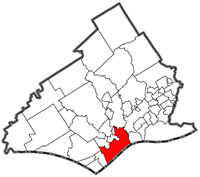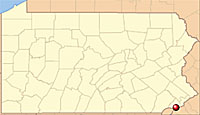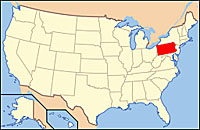The once-polluted Wade site occupies three acres on the west bank of the Delaware River immediately north of the Commodore Barry Bridge in Chester PA. From around 1950 to the early 1970s, it housed a rubber recycling facility called the Eastern Rubber Reclaiming. Later, it was illegally converted into an industrial waste storage and disposal facility, which posed tremendous environmental risks to the community. In 1978, an intense fire exacerbated the hazards, and with governmental intervention, cleanup activities were successfully conducted to turn the site into a safe parking space.
The Wade site became an area for serious concern when it became an illegal waste dump. Although the nearest residential area lay only about 1,000 feet away, workers stored drums on the site, and/or deposited their contents either directly on the ground or into trenches. The ground was stained in bright-colored patches from the chemicals, and deadly fumes emanated from the ground, melting the shoes of those who ventured by. Toxic chemicals and heavy metals, such as arsenic, chromium, mercury, lead, PCBs, plastic resins, volatile organic compounds, acids, and cyanide salts severely threatened the safety of Chester citizens. Public outcry to remove this facility was largely ignored.
By 1978, there were nearly three million gallons of deadly industrial waste at the Wade site. On February 2nd of that year, an enormous fire engulfed the dump, destroying one warehouse and causing irreparable damage to two other buildings which housed drummed wastes. The origin of the fire remains a mystery to this day. Forty-seven fighters were hospitalized, and all developed diseases including cancer, vascular and neuromuscular disorders, kidney failure and more – presumably due to the harmful nature of the chemical fumes.
Many more families suffered as a result of the diaster, and little was done to help them. After years of legal battle, the victims were given minimal compensation by the companies responsible. Haulers Ellis Morrell “Sparky” Barnhouse and Franklin P. Tyson of ABM Disposal Service Co were not criminally prosecuted. Melvin Wade, the owner and namesake of the dump, was given a light sentence.
After the fire, about 150,000 gallons of hazardous waste materials remained. No one could be bothered enough to put up a cautionary fence around the site, and many scavengers and children frequented the area, coming in close contact with the toxins within.
In order to undertake the enormous task of cleanup, millions of dollars were needed. Again, after a long legal struggle between the state and a total of 36 companies responsible for the waste, the money was raised. Cleanup activities were conducted form 1981 to 1989 by the U.S. Environmental Protection Agency, or EPA and the Pennsylvania Department of Environmental Protection, orDEP, to remove nearly 155 tons of contaminated solids from the Superfund site. Finally in 1989, the Wade site was deemed safe.
In 2000, The Philadelphia Inquirer published an eight-part series on the aftermath of the fire.
Summary:
- Located on the west bank of the Delaware River immediately north of the Commodore Barry Bridge in Chester PA.
- Cleanup Activities from 1981 to 1989 by the U.S. Environmental Protection Agency and the Pennsylvania Department of Environmental Protection (PADEP).
- Deleted from the National Priorities List (NPL) in 1989.
- Newly built (2004) asphalt surface and engineered storm water drainage.
- Now redeveloped as a parking space.
- Site now considered safe.
- Three-acre.
- Nearest residential area about 1,000 feet away.
- Used as a rubber recycling facility, then converted to an illegal industrial waste storage and disposal facility from around 1950 up to 1978.
- Drums stored.
- Contents dumped either directly on the ground or into trenches. Severe contamination of soil and ground water (with heavy metals including arsenic, chromium, mercury, lead, PCBs, plastic resins, volatile organic compounds, acids, cyanide salts.
- 1978 fire destroyed one building, caused extensive damage to two others which contained drummed wastes.
- Forty-seven firefighters hospitalized.
- About 150,000 gallons of waste materials remained after the fire.
- Numerous threats to residents, and the environment.
- Removal of 155 tons of contaminated solids.
- Cleanup included removing, decontaminating, and disposing of tires, tankers, waste piles, and buildings; contaminated soil removal, site levelling, filling, and grading.


